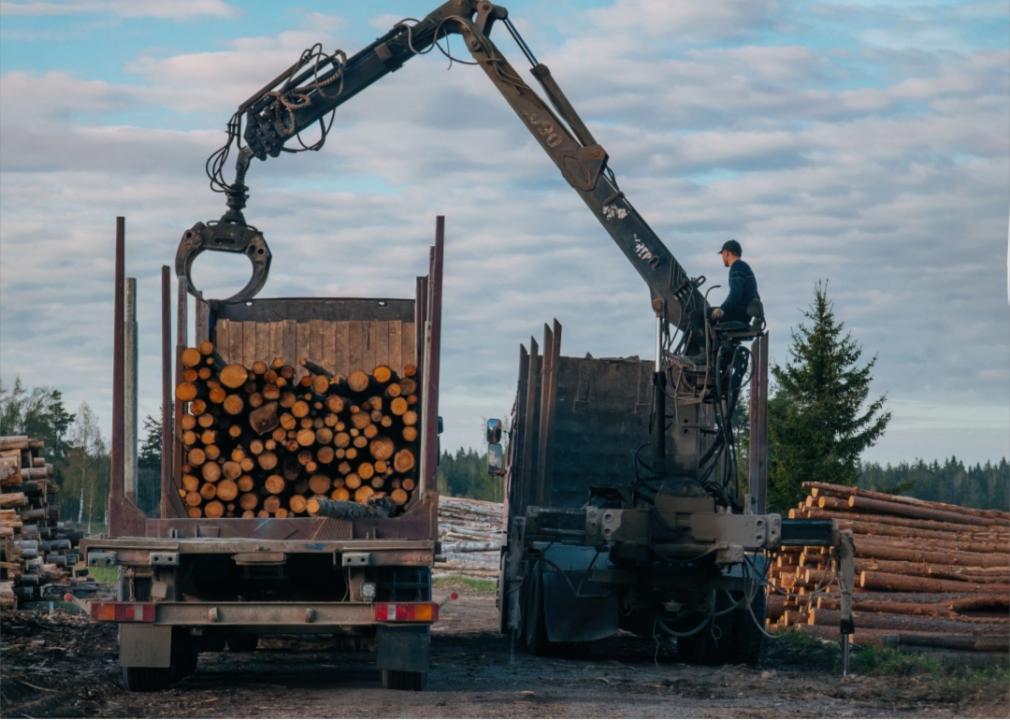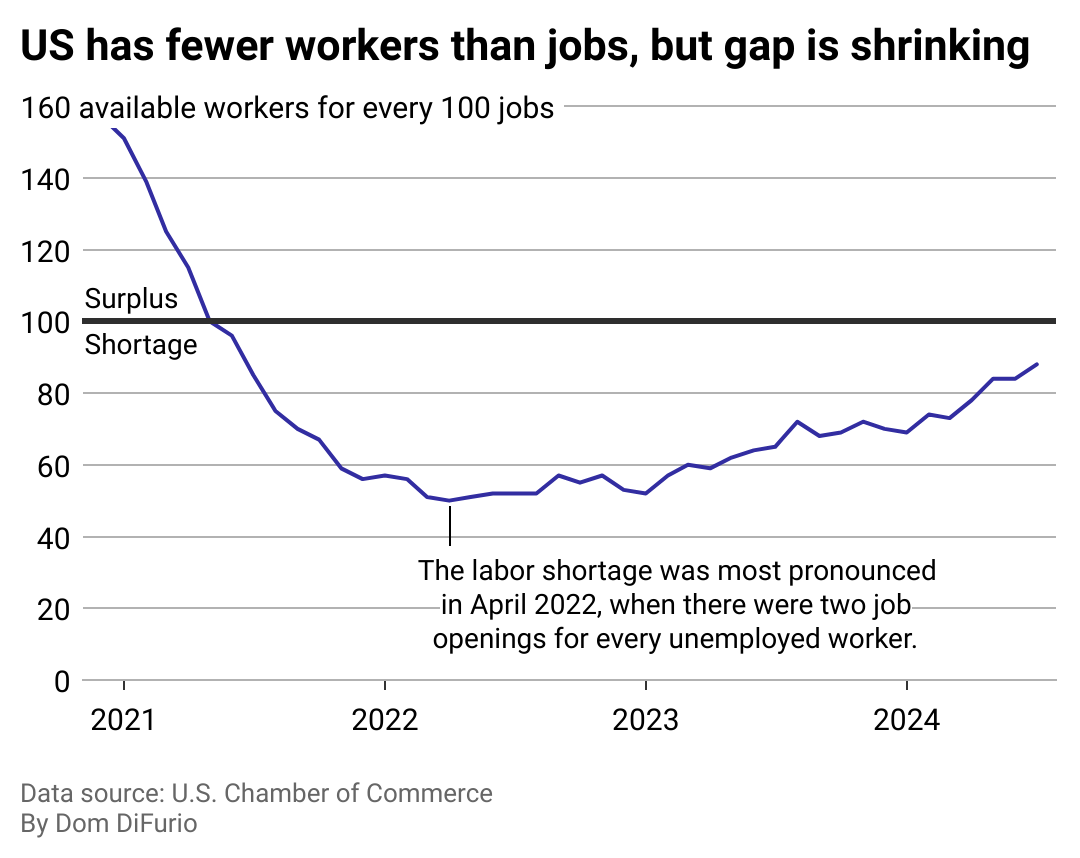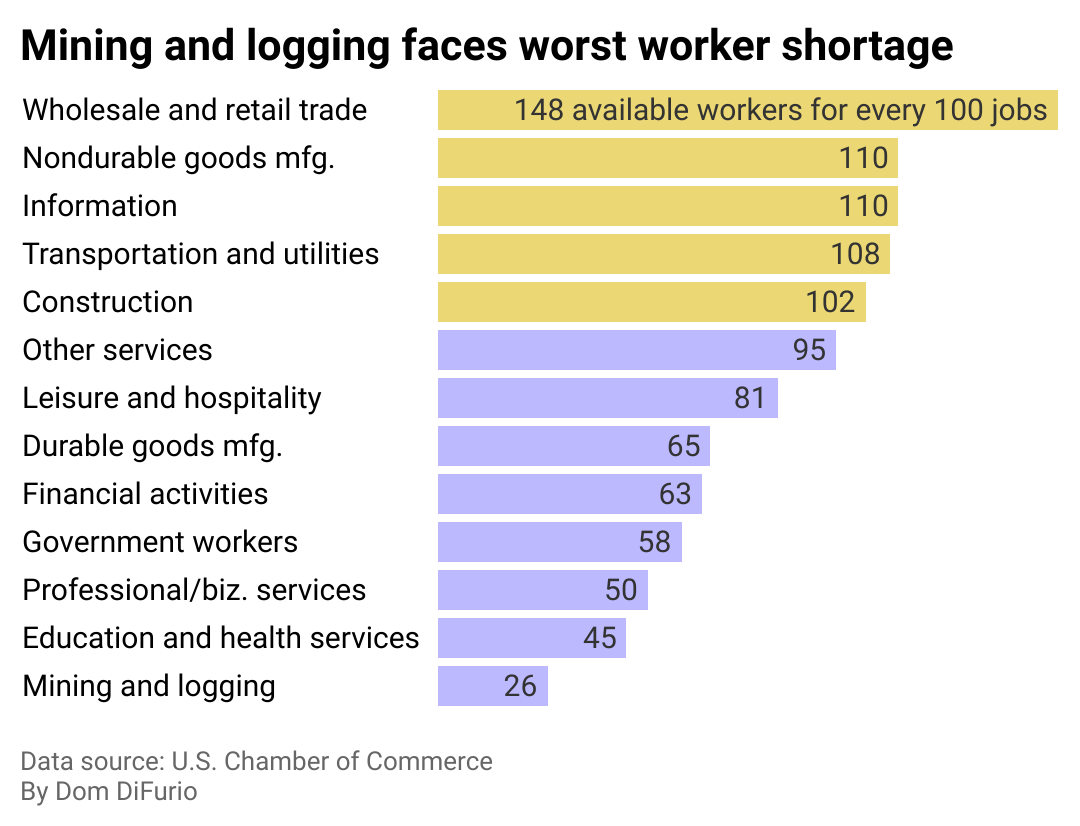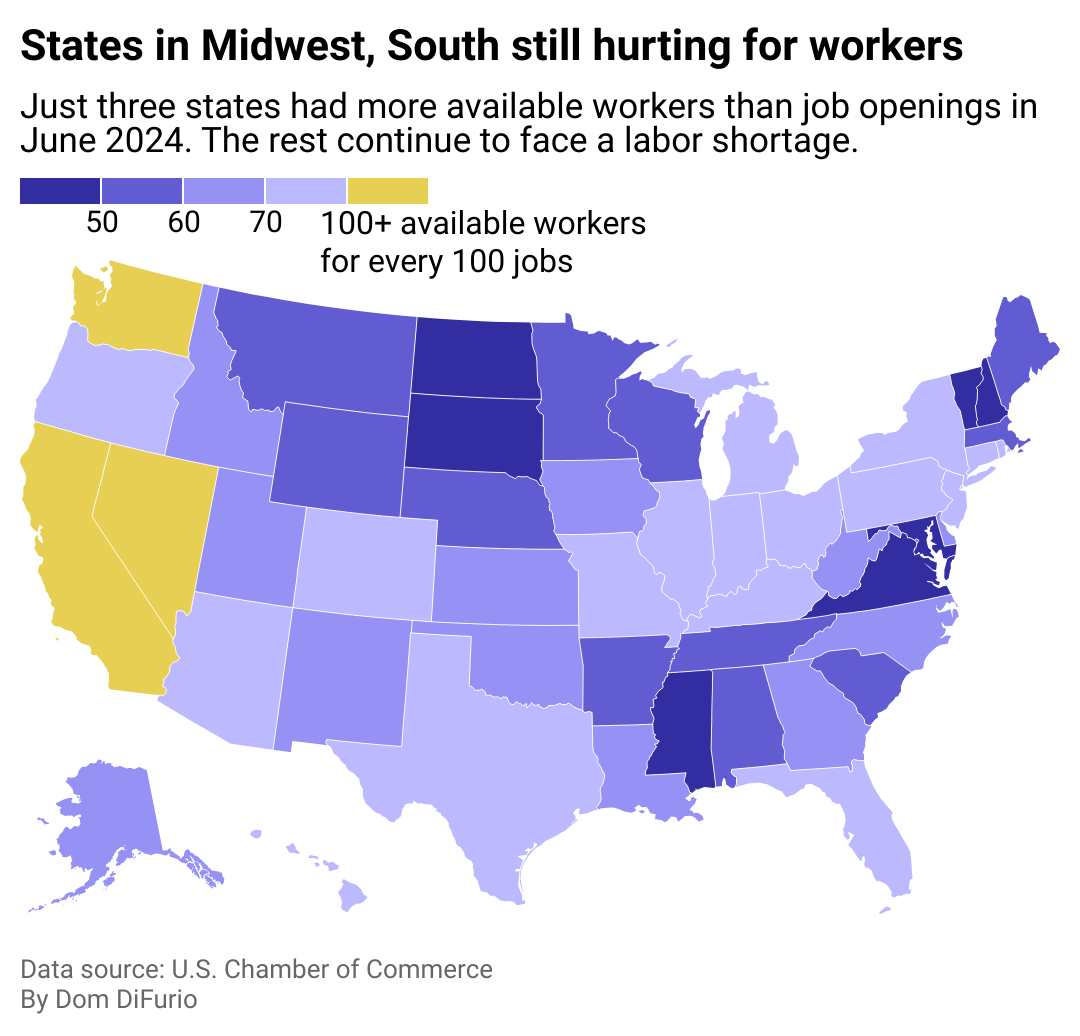The worker shortage isn't over. Here are the states where it's most acute.

Vladimir Mulder // Shutterstock
The worker shortage isn’t over. Here are the states where it’s most acute.
A large crane is positioned near the truck. The crane’s arm is extended, holding a grapple that is lifting logs from the ground.
The “most unusual job market in modern American history.” The “Great American Labor Shortage.” That’s how news reports were describing the massive disruption to the job market delivered by the COVID-19 pandemic by the latter half of 2021, when almost half of American companies were reporting a worker shortage.
Since then, the job market has shifted back toward something more akin to what the U.S. was used to before the pandemic arrived. But some industries and parts of the country are still hurting for workers—a trend that’s had ongoing ramifications for workers and consumers.
JobTest.org analyzed Bureau of Labor Statistics data compiled by the Chamber of Commerce to illustrate the current state of America’s ongoing labor shortage. The analysis uses the most recent data available at the national and state levels, from July and June 2024 respectively.
According to government jobs data, there were 8.2 million open jobs in the U.S. in July and only 7.1 million unemployed workers. Even if every unemployed worker had a job, the nation would still have millions of unfilled positions.
A shortage of workers can be a double-edged sword for consumers. On one hand, it means there are jobs available, and workers have some leverage to negotiate higher wages. On the other hand, it can cause companies to raise the price of the goods and services they offer to cover the cost of wage increases and attract more candidates to an open position. In the case of industries like health care or public education, difficulty finding skilled professionals to fill open positions can also make it harder for institutions to provide necessary services to the communities they serve.
Not every unemployed worker is suited for the jobs available, however. As seen in recent years, workers in some places have seen their cost of living rise so dramatically that the jobs offered in industries for which they may be qualified—such as hospitality, food service, and retail—are no longer appealing or even feasible.
![]()

JobTest.org
A shortage that’s slowly improving
A line chart showing the ratio of job openings to unemployed Americans seeking work from 2020-June 2024. The ratio spiked to 450 unemployed workers for every 100 jobs with the COVID-19 recession. The labor shortage then peaked in 2022 at 50 workers for every 100 jobs and has recovered some since, now sitting at 84 workers for every 100 jobs.
Still, Americans have trickled back into the workforce at a steady pace as short-term savings stockpiled in the early years of the pandemic ran out, and the cost of essentially everything began rising starting in 2021. Many of those workers took their time getting back to work after the pandemic’s initial disruption.
Evidence shows many Americans decided to start families. Women with children were noticeably absent from the workforce in significant numbers. Still often the default child care provider, many women didn’t return to the workforce prior to 2022 as they helped their kids with schoolwork until more schools opened to in-person education. Since then, labor force participation among women between 25 and 54 has actually surpassed pre-pandemic levels, according to BLS data as of May 2023. Meanwhile, many older Americans decided to pull the trigger early on retirement with no plans to return.
While some of those forces have eased, certain industries are still struggling to fill the positions they need.

JobTest.org
Industries where finding workers is hardest
A bar chart showing the unemployed workers in every industry for every job opening. Wholesale and retail trade had the largest surplus of labor with 148 available unemployed workers for every 100 job openings. Industries with shortages include leisure and hospitality, durable goods manufacturing, financial activities, government workers, professional and business services, education and health services, and mining and logging.
Several industries seeing the largest shortages of workers are feeling the early impacts of an aging workforce. In mining, the typical worker is reaching retirement age and not enough young workers are entering those jobs. McKinsey reported a 39% decrease in mining graduations in the United States since 2016. It’s a trend coming to a head as the U.S. finds renewed importance in sourcing metals like copper, lithium, and manganese domestically. U.S. firms are expected to increase their demand for metals with the transition to green technologies such as electric vehicles and solar energy.
In education, the teaching population has similarly been aging out of prime working years as the field has struggled to attract new, younger professionals. ADP Research Institute created indexes that measure employment and wages and found that teacher salaries have increased more slowly than the rest of the workforce, especially for those between 20 and 30 years old.
In health care, pandemic burnout, cost-cutting, and low wages have led to understaffing in many parts of the country. The American Medical Association estimates that about 83 million Americans don’t have access to a primary care physician.
Even in the financial services world, companies are struggling to find enough trained professionals to fill accounting roles. About 3 in 4 accountants in the U.S. are near or close to retirement age, yet the number of people taking CPA exams fell to a 17-year low in 2022, just above 67,000, according to the American Institute of Certified Public Accountants. This has placed added pressure on leaders in the field to cut down education requirements for accounting.

JobTest.org
States with the largest labor shortages
A map of the U.S. showing the ratio of unemployed workers to job openings. Nevada, Washington, and California have a surplus of workers, whereas midwestern and southern states including the Dakotas, Vermont, Virginia, and Maryland have more than two job openings for every available worker.
Location can be another important factor influencing companies’ ability to find qualified workers willing to accept open positions. Only three states—Washington, Nevada, and California—have more unemployed workers than job openings.
In Maine, Wyoming, Mississippi, New Hampshire, Maryland, Virginia, Vermont, South Dakota, and North Dakota, there are still roughly two job openings for every available worker, similar to the national average at its most extreme in 2022. They’re the states where the labor shortage is most dire.
Wages offered, work hours sought, existing skill sets, work experience, and the geographic location of the job can all influence the likelihood of matching unemployed workers to in-demand job openings.
Over the last few years, as job openings have far exceeded the unemployed population, reports have suggested that labor shortages could be due in part to a discrepancy between workers and employers on any or several of those factors—mismatched expectations on wages being among the most prominent. Employers have raised pay in certain industries like hospitality in response.
However, states are also attempting workforce training programs and efforts to find workers outside the U.S. willing to work for advertised rates. States like North Dakota, where jobs data suggests labor shortages are especially pronounced, are now pouring tax dollars into attracting immigrants to fill those positions and developing grant programs to find other innovative solutions to its workforce challenges.
Story editing by Carren Jao. Additional editing by Kelly Glass. Copy editing by Tim Bruns.
This story originally appeared on jobtest.org and was produced and
distributed in partnership with Stacker Studio.